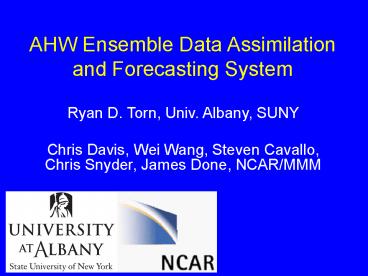AHW Ensemble Data Assimilation and Forecasting System - PowerPoint PPT Presentation
1 / 14
Title:
AHW Ensemble Data Assimilation and Forecasting System
Description:
AHW Ensemble Data Assimilation and Forecasting System Ryan D. Torn, Univ. Albany, SUNY Chris Davis, Wei Wang, Steven Cavallo, Chris Snyder, James Done, NCAR/MMM – PowerPoint PPT presentation
Number of Views:153
Avg rating:3.0/5.0
Title: AHW Ensemble Data Assimilation and Forecasting System
1
AHW Ensemble Data Assimilation and Forecasting
System
- Ryan D. Torn, Univ. Albany, SUNY
- Chris Davis, Wei Wang, Steven Cavallo, Chris
Snyder, James Done, NCAR/MMM
2
Overview
- Since participation in HFIP HRH test, we have
been using cycling EnKF approach to create
initial conditions for AHW model - Wanted initial conditions that
- Have a good estimate of environment
- Have a decent estimate of TC structure
- Does not lead to significant initialization
problem - Since then, we have upgraded the system based on
observed flaws in both model and initial
conditions
3
Assimilation System
- WRF ARW (v3.3), 36 km horizontal resolution over
basin, 96 ensemble members, DART assimilation
system. - Observations assimilated each six hours from
surface and marine stations (Psfc), rawinsondes,
dropsondes gt 100 km from TC, ACARS, sat. winds,
TC position, MSLP, GPS RO
- Initialized system this year on 29 July,
continuous cycling using GFS LBC - No vortex bogusing or repositioning, all updates
to TC due to observations
4
AHW Model Setup
- WSM6 Microphysics (includes graupel)
- Tiedtke cumulus parameterization (includes
shallow convection) - YSU PBL, NOAH land surface model
- Updated Ck/Cd formulation in Davis et al. 2010
- Pollard 1D Column ocean model
- SSTs from NCEP 1/12 degree analysis
- HYCOM Mixed-layer depths
5
Data Assimilation Nesting Strategy
- Each time NHC declares an INVEST area, generate a
12 km resolution two-way interactive nest that
moves with the system until NHC stops tracking it
(1600 km x 1600 km nest) - Observations are assimilated on the nested domain
each 6 h - Nest movement determined by extrapolating NHC
positions over the previous 6 h - Works better than vortex-following nests, which
have largest covariances associated with
differences in land position
6
Nest Example
Earl
Fiona
INVEST
Gaston
7
Cycling Nest Experiments
- No Nest (HRH test setup)
- Fixed 12 km two-way nest (1000 km x 1000 km)
generated for each TC in domain at each analysis
time. Discarded at end of model advance (2009
real-time setup) - Moving 12 km two-way nest (1000 km x 1000 km)
generated when TD is declared. Nest is cycled
along with the coarse domain. Motion based on
NHC advisory position over previous 6 hr (2010
real-time setup)
8
TC Vitals Error
RMS Error
Bias
9
Deterministic Forecast
- For each TC, choose one analysis ensemble member
whose TC properties are closest to ensemble mean
(see below) - Remove other 12 km nests, add additional 4 km
nest to 12 km for that storm (800 km on a side),
runs without cumulus parameterization.
10
2011 Retrospective Forecasts
Track
Maximum Wind Speed
11
Ensemble Forecasts
- Currently running 15 member ensemble for NHC
highest priority TC - Take first 15 members of the analysis ensemble
since all are equally likely - All members use same lower BC, lateral BC, and
model physics (will be relaxed in the future)
12
0000 UTC 2 Aug. Ensemble
13
(No Transcript)
14
Lessons to Date
- Ensemble can produce fairly large variance in
intensity without significant variance in
large-scale environment parameters - Biases due to deficiencies in model physics (in
particular aerosol and ozone treatment) lead to
many situations where truth is outside ensemble































